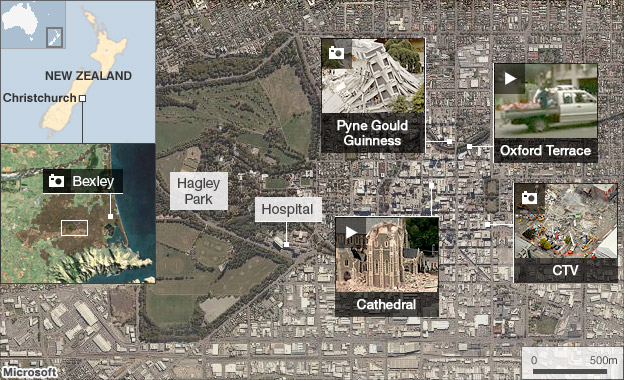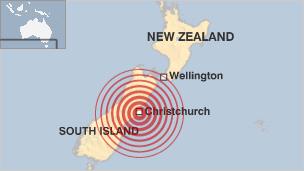New Zealand earthquake: 65 dead in Christchurch
- Published
Eyewitness Tania Galbraith: "The whole building began to shake and it just wouldn't stop"
New Zealand's prime minister says at least 65 people have died after a 6.3-magnitude earthquake hit Christchurch.
John Key said the toll was expected to rise further, adding: "We may be witnessing New Zealand's darkest day."
The tremor caused widespread damage as it occurred at a shallow depth of 5km (3.1 miles) during lunchtime when Christchurch was at its busiest.
The mayor of New Zealand's second-biggest city says 120 people have been rescued from the ruins.
The country's deadliest natural disaster in 80 years struck at 1251 (2351 GMT on Monday), 10km (6.2 miles) south-east of the city.
Screams from rubble
The damage is said to be far worse than after the 7.1-magnitude quake on 4 September, which left two people seriously injured but no fatalities.
The epicentre of that quake, which occurred in the middle of the night, was further away from the city and deeper underground, but it still caused an estimated $3bn (£1.9bn) in damage.
TV pictures of the aftermath of Tuesday's disaster showed scores of collapsed buildings in the South Island city of nearly 400,000 people.
Shocked survivors could be seen wandering the rubble-strewn streets, which cracked open as the ground beneath was liquefied by the tremor.
Police said that the dead included people on two buses which were crushed by falling buildings.
Helicopters plucked survivors to safety from rooftops, and dumped water on fires.
Officials said up to 30 people were feared still trapped inside the razed Pyne Gould Guinness building, where screams have been heard from the ruins.
CLICKABLE Select the images for more details.

Bexley

Streets in the north-eastern suburb of Bexley were flooded as the quake caused water mains to burst, which coincided with heavy rain.
Pyne Gould Guinness

The multi-storey Pyne Gould Guinness Building, which normally houses around 200 workers, collapsed. A number of people were thought to be trapped inside.
Cathedral

The 63m spire of the city's Anglican cathedral was toppled by the earthquake. A New Zealand TV reporter took a look inside the damaged building.
CTV building

Part of Christchurch's Canterbury Television [CTV] building completely collapsed in the earthquake. Some 24 people have been rescued from the building, but police said there might be between 60 and 120 bodies trapped underneath.
Oxford Terrace

In the aftermath of the earthquake, Rhys Taylor took this video on Oxford Terrace, 50 metres away from the city's main hospital. He said: "Cars were being used as ambulances to transport the injured."
Trapped under her desk inside the building, Anne Voss told Australia's Channel Seven by mobile phone: "I am hoping they will get me out soon because I have been here so long. And it's dark. And it's horrible."
Asked whether she was injured, she said: "I know I am bleeding and I can feel the ground is quite wet. I think it's blood."
Glacier smashed
A dozen visiting Japanese students are among those reported missing.
Bystanders have been using bare hands to try to free survivors trapped under debris.
Many injured people were carried out on blood-soaked stretchers or in the arms of shocked workmates and strangers.
Some escaped on ropes lowered from office towers. Others managed to crawl out of the rubble.
The tremor sent the spire of Christchurch Cathedral, a landmark in the centre of the city, toppling into the square below.
John Gurr, a camera technician, told Reuters news agency the area outside the cathedral was "like a warzone".
Power and telephone lines have been knocked out, while burst pipes have deluged streets with water.
The suburbs of Lyttelton and New Brighton are reportedly "unliveable".
Queen Elizabeth II said in a statement she had been "utterly shocked" by the news.
"My thoughts are with all those who have been affected by this dreadful event," the statement said.
The quake caused some 30m tons of ice to shear away from New Zealand's biggest glacier.
Witnesses say massive icebergs formed when the Tasman Glacier in Aoraki/Mount Cook National Park broke, tossing a nearby lake with huge waves.
Back in Christchurch, emergency shelters were set up in the city's Hagley Park, a race course and schools as night approached.
City Mayor Bob Parker told the BBC: "This is a terrible, terrible toll on our city."
"There is no power in most of the city; there is no water in most of the city," he added.
PM John Key said: "It is just a scene of utter devastation. We have to work as fast as we can to get people out of environments where they are trapped.
Grant Beedie in Christchurch: "There was no time to run, we just had to dive down on the ground and pray for some good luck"
"This is a community that is absolutely in agony. We just need this community, as it has done before and as it will do again, to come together, to check and support one another," he added.
Aftershocks
The military has been deployed to help the rescue effort, and the government has accepted an offer of specialist help from Australia.

A series of aftershocks, some as big as magnitude 5, have already rattled the stricken city, and officials warned residents to brace for more.
One Christchurch resident, Jaydn Katene, told the New Zealand Herald: "We've had friends in town call us and say there are just bodies lying around; lots of dead bodies outside shops just lying there just covered in bricks."
A British backpacker said the city "looked like a bomb had hit it".
New Zealand experiences more than 14,000 earthquakes a year, of which only around 20 have a magnitude in excess of 5.0.
The last fatal earthquake was in 1968, when a 7.1-magnitude tremor killed three people on the South Island's western coast.
Tuesday's was the country's worst natural disaster since a 1931 quake in the North Island city of Napier killed 256 people.
- Published22 February 2011
- Published22 February 2011
- Published22 February 2011
- Published8 September 2010